Black rhino facts for kids, students and adults. Find out about this critically endangered African rhinoceros, including its habitat, diet, related animals and why it is threatened.
Be sure to watch the incredible video of a black rhino chasing a pack of African wild dogs away from a water hole!
- You can find pictures, facts and information about many other endangered animals here: Endangered Animals List.
- See more amazing African animals here: African Animals List.
- Become an animal expert! Visit our main animals page: Animals: The Ultimate Guide.
Black Rhino Facts At A Glance
- Other name(s): Hook-lipped rhinoceros
- Scientific name: Diceros bicornis
- Type of Animal: Mammal
- Animal Family: Rhinocerotidae
- Where found: Eastern and Southern Africa
- Height: 55-71in
- Length: 9.8-12.3ft
- Weight: 1,760-3,090 lbs.
- Conservation status: Critically Endangered
Black Rhino Facts: Introduction
The black rhinoceros is one of the two rhinoceros species found in Africa, the other being the white rhinoceros.
There are five species of rhinoceros in total. The three other species (the Indian, Javan and Sumatran rhinos) are found in Asia.
For much of the 20th century, the black rhino was the most numerous rhino species. Today it is critically endangered, and fighting for its very survival. We’ll take a look at the reasons behind this decline further down the page.
Meet the Black Rhino
Like all rhinos, the black rhino is a large, powerful animal. Weighing as much as a car, with tough, multi-layered skin that is over an inch thick in places, and armed with two formidable horns, it is no surprise that an adult black rhino has no natural predators.
The black rhino's massive body is held up by four relatively short legs. Each of its feet has three toes. (The black rhino is a member of Perissodactyla, a group of animals also known as odd-toed ungulates.)
Don’t be deceived by the black rhino’s bulky appearance; it is capable of charging at 34 mph (55 km/h).
The rhino’s brain is relatively small in comparison to the size of its body.
Black Rhino Horns
The black rhino has two horns on its nose. In rare cases, a third, smaller, horn may be present.
The front horn is the longest. It grows to lengths of 60 cm (24 in), and may be even longer in some individuals.
The horns are made of a natural substance called keratin, the same substance from which our hair and nails are made.
Both male and female black rhinos have horns.
The black rhino uses its horns to defend itself and to attack rivals. The horns are also used for digging up roots and breaking off bits of foliage to eat.
How Big is the Black Rhino?
Both the white rhino (the largest rhino species) and the Indian rhino are larger than the black rhino.
However, the black rhino is still one of the largest land animals in the world! It stands 1.4 to 1.8 m (4.6 to 5.9 ft.) high at the shoulder. Its body is 3 to 3.75 m (9.8–12.3 ft.) in length.
The black rhino weighs from 800 to 1,400 kg (1,760 to 3,090 lb.); about the same as a car.
Black Rhino vs White Rhino
The black rhino is smaller than the white rhino, and has less of a hump above its front legs.
You might think that black and white rhinos could easily be told apart by their respective colors, but the names are misleading!
Despite its name, the black rhino is actually grey. The same color, in fact, as the white rhino. The species can’t reliably be told apart by their color, which varies depending on the soil of the area they inhabit. (Their skin is also usually covered with dry mud, which doesn't help!)
The best way of telling the black rhino and the white rhino apart is by looking at their mouths. The black rhino has a hooked, beak-shaped upper lip whereas the white rhino has a wide, flat lip.
The difference between their lips reflects the difference in the species’ feeding habits.
- The black rhino is a browser, plucking food from plants above ground level.
- The white rhino is a grazer, eating grass that grows close to the ground.
The black rhino’s pointed upper lip is prehensile. This means that it is able to grab and manipulate objects. The black rhino uses its flexible lip to move plants closer to its mouth.
Confusing Names!
The black and white rhinos’ confusing names stem from the difference between the shape of their lips. Early Dutch settlers used the Dutch word ‘wijd’, which means ‘wide’, to refer to the white rhino, because it has wider lips.
English speakers thought they were saying ‘white’ rather than ‘wijd’. Therefore the only other rhino species in Africa became known as the ‘black’ rhino!
Relations
Rhinos are members of the order Perissodactyla, also known as the odd-toed ungulates. Other members of this group include horses and tapirs.
You can find out more about orders and other animal groups here: Animal Classification.
The black rhino is a member of the family Rhinocerotidae. This family contains all 5 extant (living) rhino species, together with numerous extinct species.
The black rhino has a number of subspecies, several of which are now extinct. Surviving subspecies include the eastern black rhinoceros (Diceros bicornis michaeli), south-central black rhinoceros (D. b. minor) and south-western black rhinoceros (D. b. occidentalis).
Black Rhino Facts: Where do Black Rhinos Live?
Black rhinos live in a number of warm habitats, including savannas, grasslands, woodlands and forests. They are reliant on an adequate supply of shrubs and trees, and a water supply.
Black rhinos are found in Kenya, Tanzania, Namibia, Zimbabwe, South Africa, Cameroon, Malawi and Swaziland.
Diet: What do Black Rhinos Eat?
The black rhino’s diet consists of leaves, branches, shoots, fruit and other plant material taken from trees and shrubs. Other animals benefit from their diet, as the lack of woody plants allows for grass to grow.
Oxpeckers
The black rhino is often seen with birds called oxpeckers sitting on its back. There are two species of oxpecker: the red and the yellow-billed oxpecker. To them, the black rhino is a walking restaurant, with ticks, insects and insect larvae all being found on its thick skin.
Scientists are unsure whether or not the rhino benefits from the oxpeckers’ attention. If the relationship benefitted both species, it would be an example of ‘mutualism’.
However, some believe that the birds are parasites, opening up wounds in their quest for food, or even feeding on the rhino’s blood!
Black Rhino Behavior in the Wild
The black rhino doesn’t have particularly good eyesight. It does, however, have good hearing, with large ears that are able to rotate towards the source of a sound. It also has an excellent sense of smell.
The black rhino is known as being the most aggressive rhino species. It has been known to charge at trees, rocks and termite mounds that, due to its weak eyesight, were perceived to be a threat. The black rhino is best approached with care: it will also charge at humans and vehicles.
Watch the video below to see what a black rhino thinks of the wild dogs it finds at its water hole!
Not a Social Animal
The black rhino is usually solitary and territorial. The species’ habitat tends to influence its social behavior, and black rhinos have been observed drinking together at water holes. Young black rhinos will also live with mature individuals.
Fighting To the Death
Fights often break out between black rhinos. These can often prove fatal, and are responsible for a high number of deaths. A staggering 50% of male and 30% of female black rhinos die from injuries sustained during fights.
Most at risk are young and old males who inadvertently stray into the territory of a dominant male. These conflicts usually result in the younger or weaker rhino being killed or injured.
Social Interaction
The black rhino relies on its excellent sense of smell to find out what its neighbors are up to. Males mark their territory both with urine and with dung piles known as ‘middens’. A female’s urine and dung tells males whether or not she’s interested in mating.
Black rhinos can tell another black rhino’s age, sex and physical condition just by sniffing its dung. Don’t try this at home!
The black rhino also scent marks trees by rubbing its head or horns against the trunk.
The black rhino is active during both at day and at night. Around midday, however, it will usually be found resting in the shade of a tree or large rock.
Black Rhino Facts: Family Life
Black rhinos usually only come together in order to mate.
Scent marks left by a female will alert the male that she is in season (ready to mate). He will then seek her out, even scraping her dung to prevent other males from locating her. Males will fight one another for access to a female.
Breeding couples can stay together for periods of a few days to up to 30 days.
The gestation period (how long a female is pregnant) of a black rhino is 15 months. When ready to give birth, a female will make her way to a secure, secluded spot. She will give birth to a single calf.
The calf feeds on its mother’s milk for around 2 months. The mother will aggressively defend her calf against predators, which include hyenas and lions.
The calf stays with its mother until she is ready to mate again. At this point the mother will begin to reject the calf, although female calves will occasionally stay and form small groups with their mother and siblings.
Female black rhinos have calves every two to three years.
Black Rhino Lifespan
The lifespan of a black rhino in the wild is between 25 and 40 years. In captivity this increases to around 45 years.
Black Rhino Predators
Black rhinos have no natural predators, although calves and young rhinos occasionally fall prey to lions. Even adult black rhinos can be taken by crocodiles, but this is a rare occurrence.
Are Black Rhinos Endangered?
The black rhino was once the most numerous of all rhinos, with a population of around 850,000 in the wild. Today its population is a fraction of this, and the species is now rated critically endangered by the IUCN.
Why Is The Black Rhino Critically Endangered?
Historically, the black rhino was heavily hunted, reducing its numbers in the wild. During the 20th century, much of the species’ natural habitat was cleared to make way for farms and towns, leading to a drastic decline in its population.
By 1960, there were only 100,000 black rhinos left. Heavy poaching between 1960 and 1995 reduced the already dwindling population by around 98%. At its lowest, the black rhino population numbered just 2,410 individuals.
The black rhino is targeted by poachers for its horns. The horns are used in Middle Eastern nations to make handles for a certain type of ceremonial dagger. In China and other Asian countries, the horns are ground up and used as a medicine.
As a conservation measure, the black rhino’s horns are sometimes removed in order to prevent its being targeted by poachers. However, this solution is far from ideal as the rhino is unable to live as effectively without its main weapons and tools.
Illegal hunting continues to be the biggest threat to the black rhino today.
There is some light at the end of the tunnel. Thanks to strict protection and monitoring of the species, the black rhino’s population is increasing.
A 2010 report found that there were 4,880 black rhinos alive in the wild, and an additional 240 in captivity throughout the world.
Black Rhino Facts: Conclusion
We hope that you have enjoyed learning about the black rhinoceros. Although its numbers have begun to increase in recent years, there is still a long way to go before it is out of danger. Why not look into ways you can help?
- You can find pictures, facts and information about many other endangered animals here: Endangered Animals List.
- See more amazing African animals here: African Animals List.
- Become an animal expert! Visit our main animals page: Animals: The Ultimate Guide.


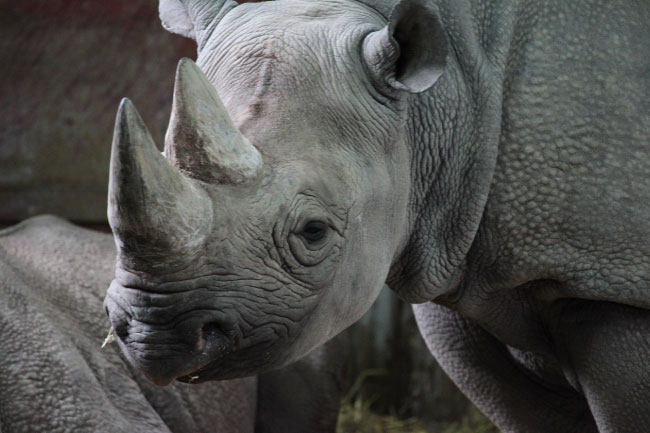
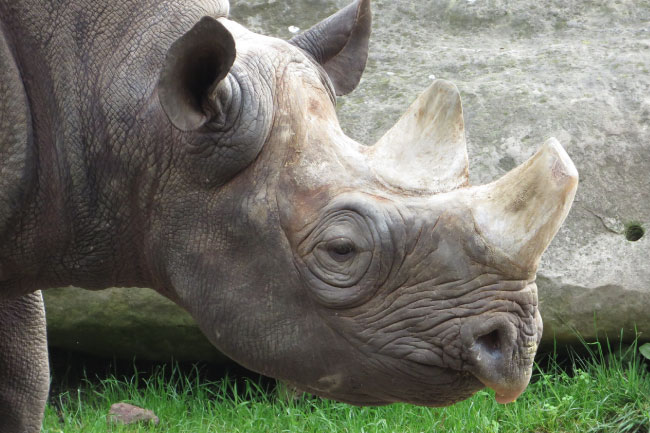
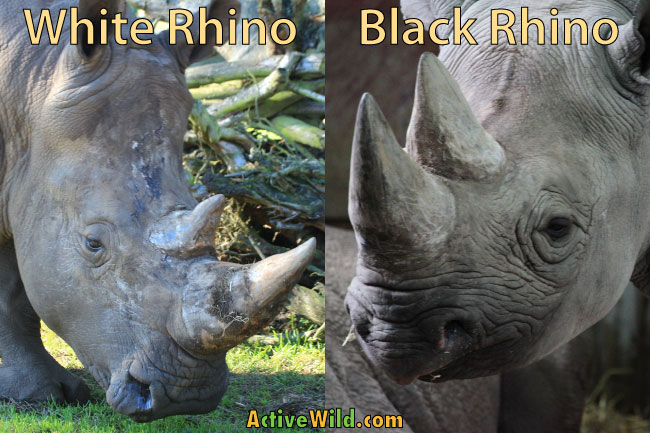
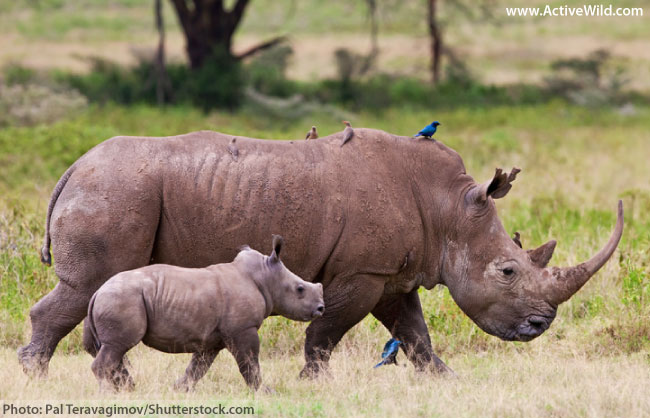
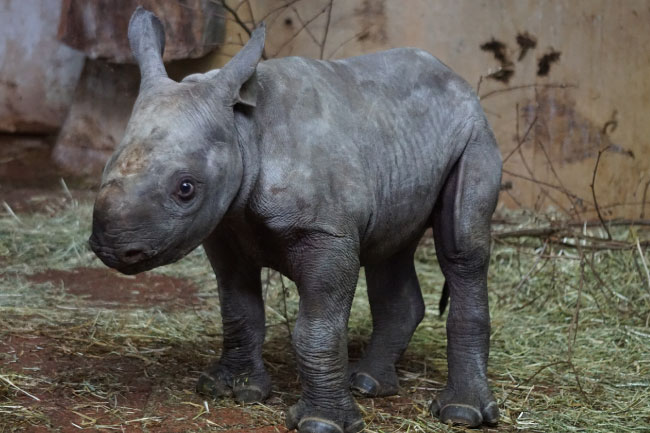

Very good and interesting for school projects